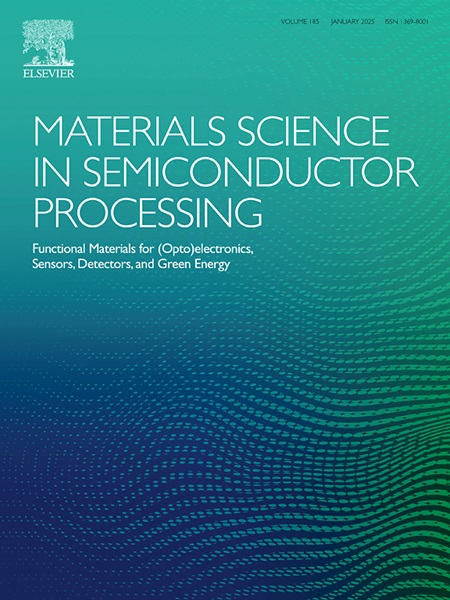利用介孔s型MnCo2O4/BaTiO3异质结促进可见光触发硝基苯转化为苯胺
IF 4.2
3区 工程技术
Q2 ENGINEERING, ELECTRICAL & ELECTRONIC
引用次数: 0
摘要
光催化将致癌物硝基苯(NTb)转化为高价值苯胺(ANL)具有经济价值和保护公众健康和生态的良好前景。有效利用太阳光谱的特殊可见光驱动光催化异质结构材料的系统进步是必不可少的。本研究涉及使用混合表面活性剂介导的溶剂热方法生长介孔钙钛矿钛酸钡(BTT)纳米晶体。接下来,将金属钴酸盐(MCT)纳米颗粒(NPs) (3-12 wt%)与BTT混合,通过超声和煅烧制备介孔阶梯型(S-scheme) MCT/BTT异质结光催化剂。综合表征验证了MCT和BTT之间建立了稳健的互连,并遵循s型途径进行了有效的电荷迁移。事实上,MCT NPs具有协同效应,显著改善了光敏性和光形成载流子在制备异质结中的不结合和迁移。这些独特的属性,以及合成的介孔二维异质结的性质,提供了丰富的活性电荷和活性位点,导致了NTb光催化转化(PCT)的显著提高。特别是,NTb分子在可见光照射50分钟内完全转化为ANL,利用最佳异质结构材料(9% MCT/BTT),最佳浓度(2.4 g/L)。该异质结构在5次反应循环中表现出极好的稳定性和增强的反应动力学(K = 0.0749 min−1),是纯BTT制备的反应动力学的46.8倍。本工作为创造性能优异且光催化稳定的光催化材料提供了实质性的思考。本文章由计算机程序翻译,如有差异,请以英文原文为准。
Boosting visible light-triggered transformation of nitrobenzene into aniline utilizing mesoporous S-scheme MnCo2O4/BaTiO3 heterojunction
The photocatalytic transforming of cancer-causing nitrobenzene (NTb) into high-value aniline (ANL) is valuable for the economy and a promising way to conserve public health and the ecology. The methodical advancement of exceptional visible-light-driven photocatalytic heterostructure materials that efficiently utilize the solar spectrum is essential. This study involved the growth of mesoporous perovskite barium titanate (BTT) nanocrystals using mixed-surfactant-mediated solvothermal methodology. Next, metal cobaltate (MCT) nanoparticles (NPs) (3–12 wt%) were mixed with BTT using sonication and calcination to manufacture mesoporous step-scheme (S-scheme) MCT/BTT heterojunction photocatalysts. A comprehensive characterization validated the creation of robust interconnection between MCT and BTT with efficient charge migration following the S-type pathway. Indeed, MCT NPs had synergistic effects, significantly improving photosensitivity and photo-formed carriers' disunion and migration in the fabricated heterojunctions. These distinguished attributes, along with the mesoporous 2D nature of the synthesized heterojunctions, which offer plentiful active charges and reactive sites, resulted in a considerable boost for photocatalytic transformation (PCT) of NTb. Particularly, NTb molecules were completely transformed into ANL within 50 min of visible illumination, utilizing the best heterostructure material (9 % MCT/BTT) at the optimal concentration (2.4 g/L). This illustrious heterostructure displayed superb stability during five reaction recycles and enhanced reaction kinetics (K = 0.0749 min−1), outperforming by 46.8 times that yielded by employing pure BTT. The present work provides substantial thinking on the creation of exceeding performance and photocatalytically stable photocatalytic materials.
求助全文
通过发布文献求助,成功后即可免费获取论文全文。
去求助
来源期刊

Materials Science in Semiconductor Processing
工程技术-材料科学:综合
CiteScore
8.00
自引率
4.90%
发文量
780
审稿时长
42 days
期刊介绍:
Materials Science in Semiconductor Processing provides a unique forum for the discussion of novel processing, applications and theoretical studies of functional materials and devices for (opto)electronics, sensors, detectors, biotechnology and green energy.
Each issue will aim to provide a snapshot of current insights, new achievements, breakthroughs and future trends in such diverse fields as microelectronics, energy conversion and storage, communications, biotechnology, (photo)catalysis, nano- and thin-film technology, hybrid and composite materials, chemical processing, vapor-phase deposition, device fabrication, and modelling, which are the backbone of advanced semiconductor processing and applications.
Coverage will include: advanced lithography for submicron devices; etching and related topics; ion implantation; damage evolution and related issues; plasma and thermal CVD; rapid thermal processing; advanced metallization and interconnect schemes; thin dielectric layers, oxidation; sol-gel processing; chemical bath and (electro)chemical deposition; compound semiconductor processing; new non-oxide materials and their applications; (macro)molecular and hybrid materials; molecular dynamics, ab-initio methods, Monte Carlo, etc.; new materials and processes for discrete and integrated circuits; magnetic materials and spintronics; heterostructures and quantum devices; engineering of the electrical and optical properties of semiconductors; crystal growth mechanisms; reliability, defect density, intrinsic impurities and defects.
 求助内容:
求助内容: 应助结果提醒方式:
应助结果提醒方式:


